Analysis of Phase Transformations, Annealing, and Phase Diagrams
VerifiedAdded on 2023/05/28
|13
|1699
|500
Report
AI Summary
This report provides a comprehensive analysis of phase transformations, focusing on annealing treatments, methods for determining phase diagrams, and the transformations occurring in unary, binary, and ternary systems. It addresses the duration of annealing treatments, explores alternative methods for determining phase diagrams like cooling curves, equilibrated alloys, and diffusion couples, and applies these methods to unary diagrams such as carbon dioxide. The report further examines binary diagrams, specifically the Copper-Nickel system, and describes phase transformations during slow cooling. Additionally, it investigates ternary phase diagrams, predicting solidification sequences and transformation temperatures for alloys like Sn-45wt%Pb-10wt%Sb, and analyzes phase changes in Fe-17wt%Cr-1wt%C alloys using isopleths, offering a detailed overview of how composition and temperature influence material phases. Desklib provides access to this and other solved assignments to aid students in their studies.
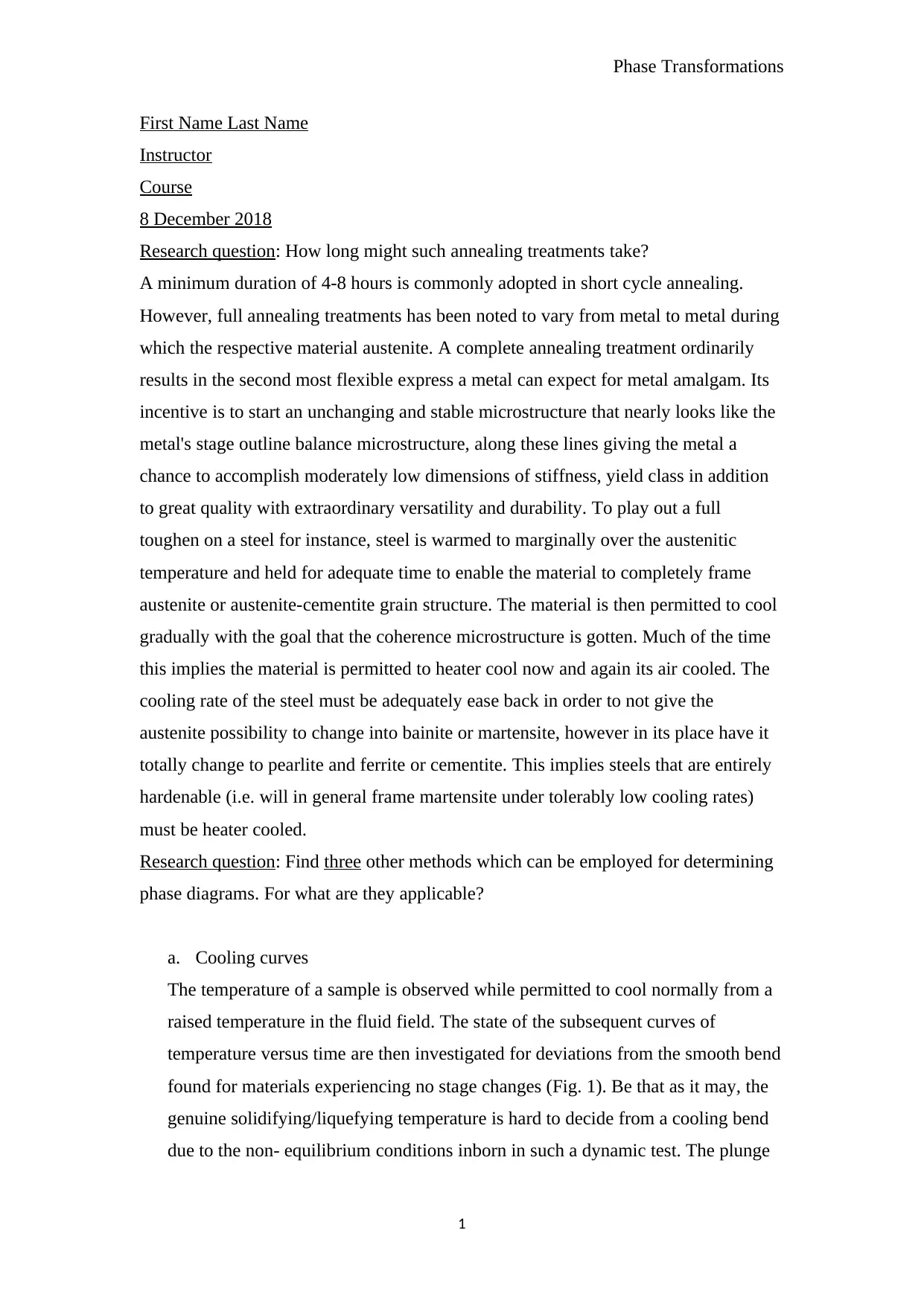
Phase Transformations
First Name Last Name
Instructor
Course
8 December 2018
Research question: How long might such annealing treatments take?
A minimum duration of 4-8 hours is commonly adopted in short cycle annealing.
However, full annealing treatments has been noted to vary from metal to metal during
which the respective material austenite. A complete annealing treatment ordinarily
results in the second most flexible express a metal can expect for metal amalgam. Its
incentive is to start an unchanging and stable microstructure that nearly looks like the
metal's stage outline balance microstructure, along these lines giving the metal a
chance to accomplish moderately low dimensions of stiffness, yield class in addition
to great quality with extraordinary versatility and durability. To play out a full
toughen on a steel for instance, steel is warmed to marginally over the austenitic
temperature and held for adequate time to enable the material to completely frame
austenite or austenite-cementite grain structure. The material is then permitted to cool
gradually with the goal that the coherence microstructure is gotten. Much of the time
this implies the material is permitted to heater cool now and again its air cooled. The
cooling rate of the steel must be adequately ease back in order to not give the
austenite possibility to change into bainite or martensite, however in its place have it
totally change to pearlite and ferrite or cementite. This implies steels that are entirely
hardenable (i.e. will in general frame martensite under tolerably low cooling rates)
must be heater cooled.
Research question: Find three other methods which can be employed for determining
phase diagrams. For what are they applicable?
a. Cooling curves
The temperature of a sample is observed while permitted to cool normally from a
raised temperature in the fluid field. The state of the subsequent curves of
temperature versus time are then investigated for deviations from the smooth bend
found for materials experiencing no stage changes (Fig. 1). Be that as it may, the
genuine solidifying/liquefying temperature is hard to decide from a cooling bend
due to the non- equilibrium conditions inborn in such a dynamic test. The plunge
1
First Name Last Name
Instructor
Course
8 December 2018
Research question: How long might such annealing treatments take?
A minimum duration of 4-8 hours is commonly adopted in short cycle annealing.
However, full annealing treatments has been noted to vary from metal to metal during
which the respective material austenite. A complete annealing treatment ordinarily
results in the second most flexible express a metal can expect for metal amalgam. Its
incentive is to start an unchanging and stable microstructure that nearly looks like the
metal's stage outline balance microstructure, along these lines giving the metal a
chance to accomplish moderately low dimensions of stiffness, yield class in addition
to great quality with extraordinary versatility and durability. To play out a full
toughen on a steel for instance, steel is warmed to marginally over the austenitic
temperature and held for adequate time to enable the material to completely frame
austenite or austenite-cementite grain structure. The material is then permitted to cool
gradually with the goal that the coherence microstructure is gotten. Much of the time
this implies the material is permitted to heater cool now and again its air cooled. The
cooling rate of the steel must be adequately ease back in order to not give the
austenite possibility to change into bainite or martensite, however in its place have it
totally change to pearlite and ferrite or cementite. This implies steels that are entirely
hardenable (i.e. will in general frame martensite under tolerably low cooling rates)
must be heater cooled.
Research question: Find three other methods which can be employed for determining
phase diagrams. For what are they applicable?
a. Cooling curves
The temperature of a sample is observed while permitted to cool normally from a
raised temperature in the fluid field. The state of the subsequent curves of
temperature versus time are then investigated for deviations from the smooth bend
found for materials experiencing no stage changes (Fig. 1). Be that as it may, the
genuine solidifying/liquefying temperature is hard to decide from a cooling bend
due to the non- equilibrium conditions inborn in such a dynamic test. The plunge
1
Paraphrase This Document
Need a fresh take? Get an instant paraphrase of this document with our AI Paraphraser
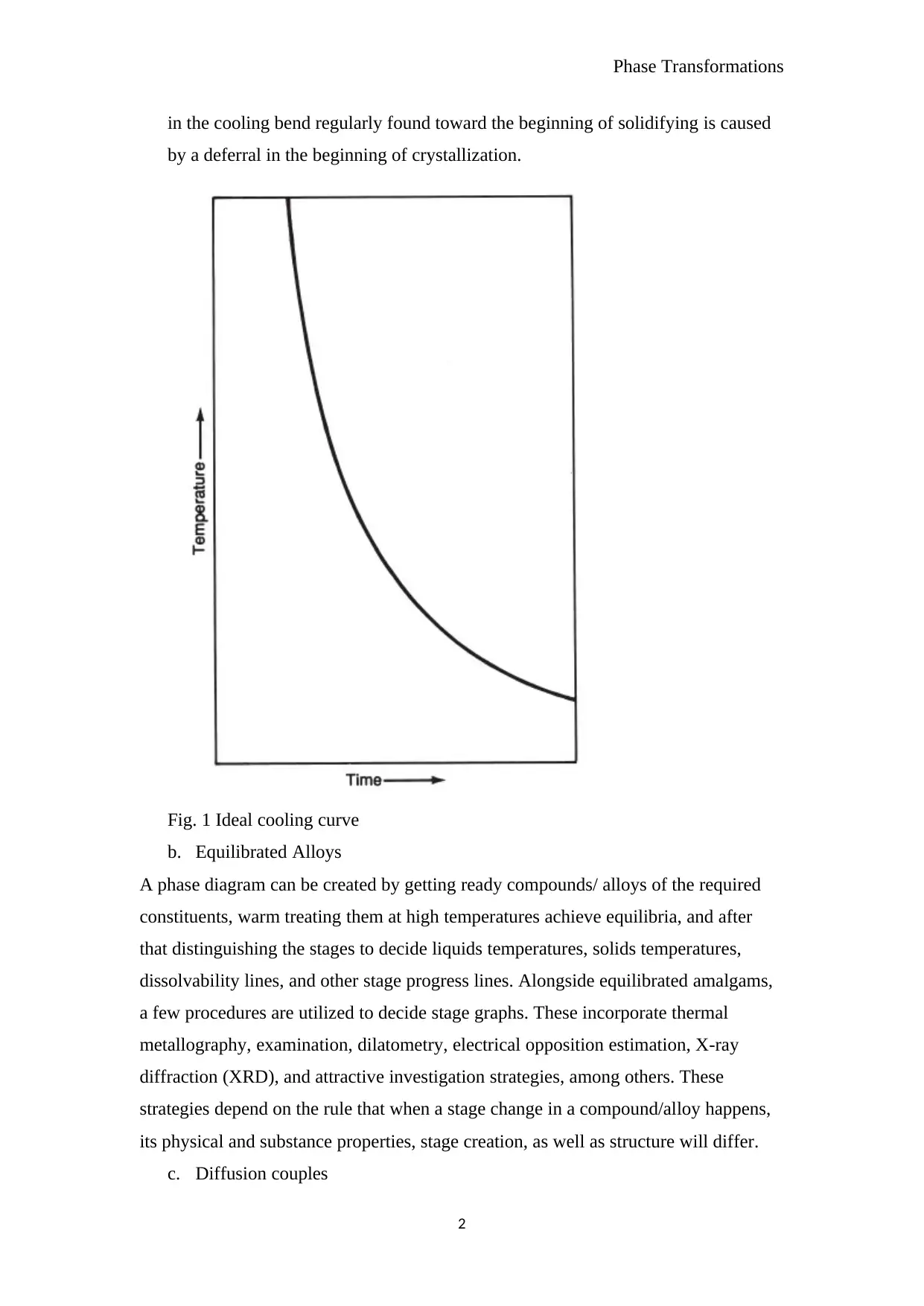
Phase Transformations
in the cooling bend regularly found toward the beginning of solidifying is caused
by a deferral in the beginning of crystallization.
Fig. 1 Ideal cooling curve
b. Equilibrated Alloys
A phase diagram can be created by getting ready compounds/ alloys of the required
constituents, warm treating them at high temperatures achieve equilibria, and after
that distinguishing the stages to decide liquids temperatures, solids temperatures,
dissolvability lines, and other stage progress lines. Alongside equilibrated amalgams,
a few procedures are utilized to decide stage graphs. These incorporate thermal
metallography, examination, dilatometry, electrical opposition estimation, X-ray
diffraction (XRD), and attractive investigation strategies, among others. These
strategies depend on the rule that when a stage change in a compound/alloy happens,
its physical and substance properties, stage creation, as well as structure will differ.
c. Diffusion couples
2
in the cooling bend regularly found toward the beginning of solidifying is caused
by a deferral in the beginning of crystallization.
Fig. 1 Ideal cooling curve
b. Equilibrated Alloys
A phase diagram can be created by getting ready compounds/ alloys of the required
constituents, warm treating them at high temperatures achieve equilibria, and after
that distinguishing the stages to decide liquids temperatures, solids temperatures,
dissolvability lines, and other stage progress lines. Alongside equilibrated amalgams,
a few procedures are utilized to decide stage graphs. These incorporate thermal
metallography, examination, dilatometry, electrical opposition estimation, X-ray
diffraction (XRD), and attractive investigation strategies, among others. These
strategies depend on the rule that when a stage change in a compound/alloy happens,
its physical and substance properties, stage creation, as well as structure will differ.
c. Diffusion couples
2
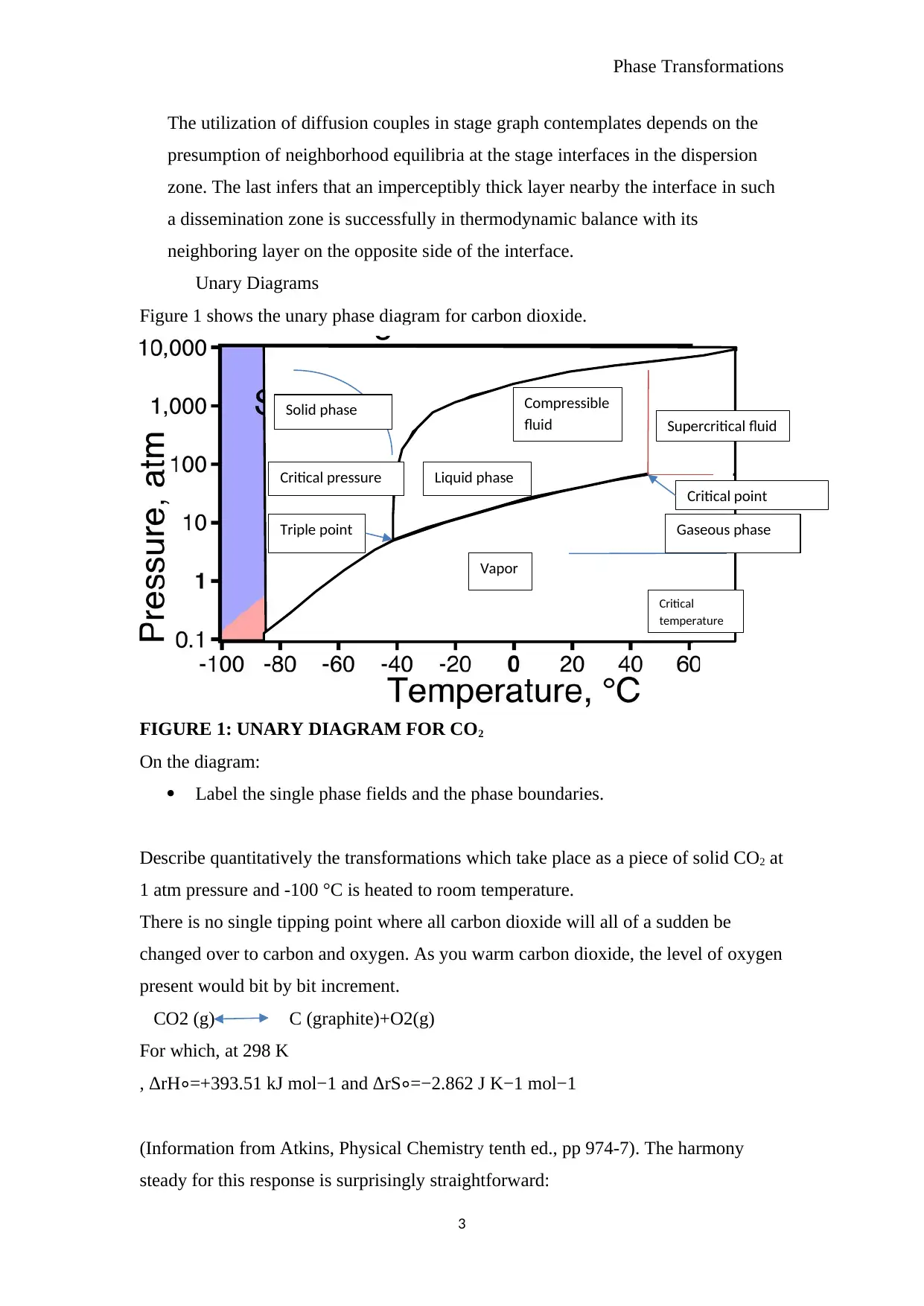
Phase Transformations
The utilization of diffusion couples in stage graph contemplates depends on the
presumption of neighborhood equilibria at the stage interfaces in the dispersion
zone. The last infers that an imperceptibly thick layer nearby the interface in such
a dissemination zone is successfully in thermodynamic balance with its
neighboring layer on the opposite side of the interface.
Unary Diagrams
Figure 1 shows the unary phase diagram for carbon dioxide.
FIGURE 1: UNARY DIAGRAM FOR CO2
On the diagram:
Label the single phase fields and the phase boundaries.
Describe quantitatively the transformations which take place as a piece of solid CO2 at
1 atm pressure and -100 °C is heated to room temperature.
There is no single tipping point where all carbon dioxide will all of a sudden be
changed over to carbon and oxygen. As you warm carbon dioxide, the level of oxygen
present would bit by bit increment.
CO2 (g) C (graphite)+O2(g)
For which, at 298 K
, ΔrH∘=+393.51 kJ mol−1 and ΔrS∘=−2.862 J K−1 mol−1
(Information from Atkins, Physical Chemistry tenth ed., pp 974-7). The harmony
steady for this response is surprisingly straightforward:
3
Supercritical fluid
Critical
temperature
Gaseous phase
Vapor
Liquid phase
Compressible
fluid
Solid phase
Triple point
Critical pressure
Critical point
The utilization of diffusion couples in stage graph contemplates depends on the
presumption of neighborhood equilibria at the stage interfaces in the dispersion
zone. The last infers that an imperceptibly thick layer nearby the interface in such
a dissemination zone is successfully in thermodynamic balance with its
neighboring layer on the opposite side of the interface.
Unary Diagrams
Figure 1 shows the unary phase diagram for carbon dioxide.
FIGURE 1: UNARY DIAGRAM FOR CO2
On the diagram:
Label the single phase fields and the phase boundaries.
Describe quantitatively the transformations which take place as a piece of solid CO2 at
1 atm pressure and -100 °C is heated to room temperature.
There is no single tipping point where all carbon dioxide will all of a sudden be
changed over to carbon and oxygen. As you warm carbon dioxide, the level of oxygen
present would bit by bit increment.
CO2 (g) C (graphite)+O2(g)
For which, at 298 K
, ΔrH∘=+393.51 kJ mol−1 and ΔrS∘=−2.862 J K−1 mol−1
(Information from Atkins, Physical Chemistry tenth ed., pp 974-7). The harmony
steady for this response is surprisingly straightforward:
3
Supercritical fluid
Critical
temperature
Gaseous phase
Vapor
Liquid phase
Compressible
fluid
Solid phase
Triple point
Critical pressure
Critical point
⊘ This is a preview!⊘
Do you want full access?
Subscribe today to unlock all pages.

Trusted by 1+ million students worldwide
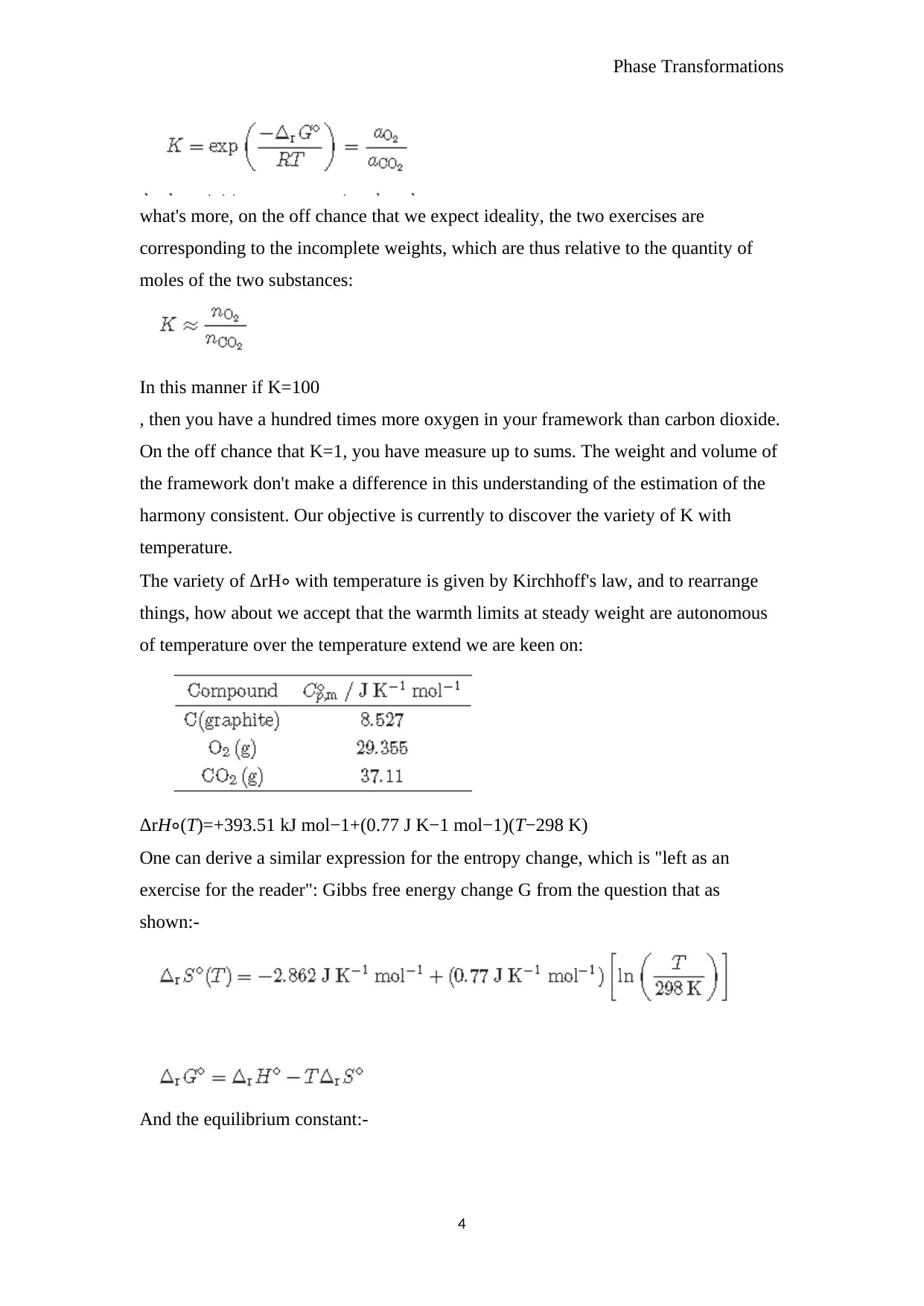
Phase Transformations
what's more, on the off chance that we expect ideality, the two exercises are
corresponding to the incomplete weights, which are thus relative to the quantity of
moles of the two substances:
In this manner if K=100
, then you have a hundred times more oxygen in your framework than carbon dioxide.
On the off chance that K=1, you have measure up to sums. The weight and volume of
the framework don't make a difference in this understanding of the estimation of the
harmony consistent. Our objective is currently to discover the variety of K with
temperature.
The variety of ΔrH∘ with temperature is given by Kirchhoff's law, and to rearrange
things, how about we accept that the warmth limits at steady weight are autonomous
of temperature over the temperature extend we are keen on:
ΔrH∘(T)=+393.51 kJ mol−1+(0.77 J K−1 mol−1)(T−298 K)
One can derive a similar expression for the entropy change, which is "left as an
exercise for the reader": Gibbs free energy change G from the question that as
shown:-
And the equilibrium constant:-
4
what's more, on the off chance that we expect ideality, the two exercises are
corresponding to the incomplete weights, which are thus relative to the quantity of
moles of the two substances:
In this manner if K=100
, then you have a hundred times more oxygen in your framework than carbon dioxide.
On the off chance that K=1, you have measure up to sums. The weight and volume of
the framework don't make a difference in this understanding of the estimation of the
harmony consistent. Our objective is currently to discover the variety of K with
temperature.
The variety of ΔrH∘ with temperature is given by Kirchhoff's law, and to rearrange
things, how about we accept that the warmth limits at steady weight are autonomous
of temperature over the temperature extend we are keen on:
ΔrH∘(T)=+393.51 kJ mol−1+(0.77 J K−1 mol−1)(T−298 K)
One can derive a similar expression for the entropy change, which is "left as an
exercise for the reader": Gibbs free energy change G from the question that as
shown:-
And the equilibrium constant:-
4
Paraphrase This Document
Need a fresh take? Get an instant paraphrase of this document with our AI Paraphraser
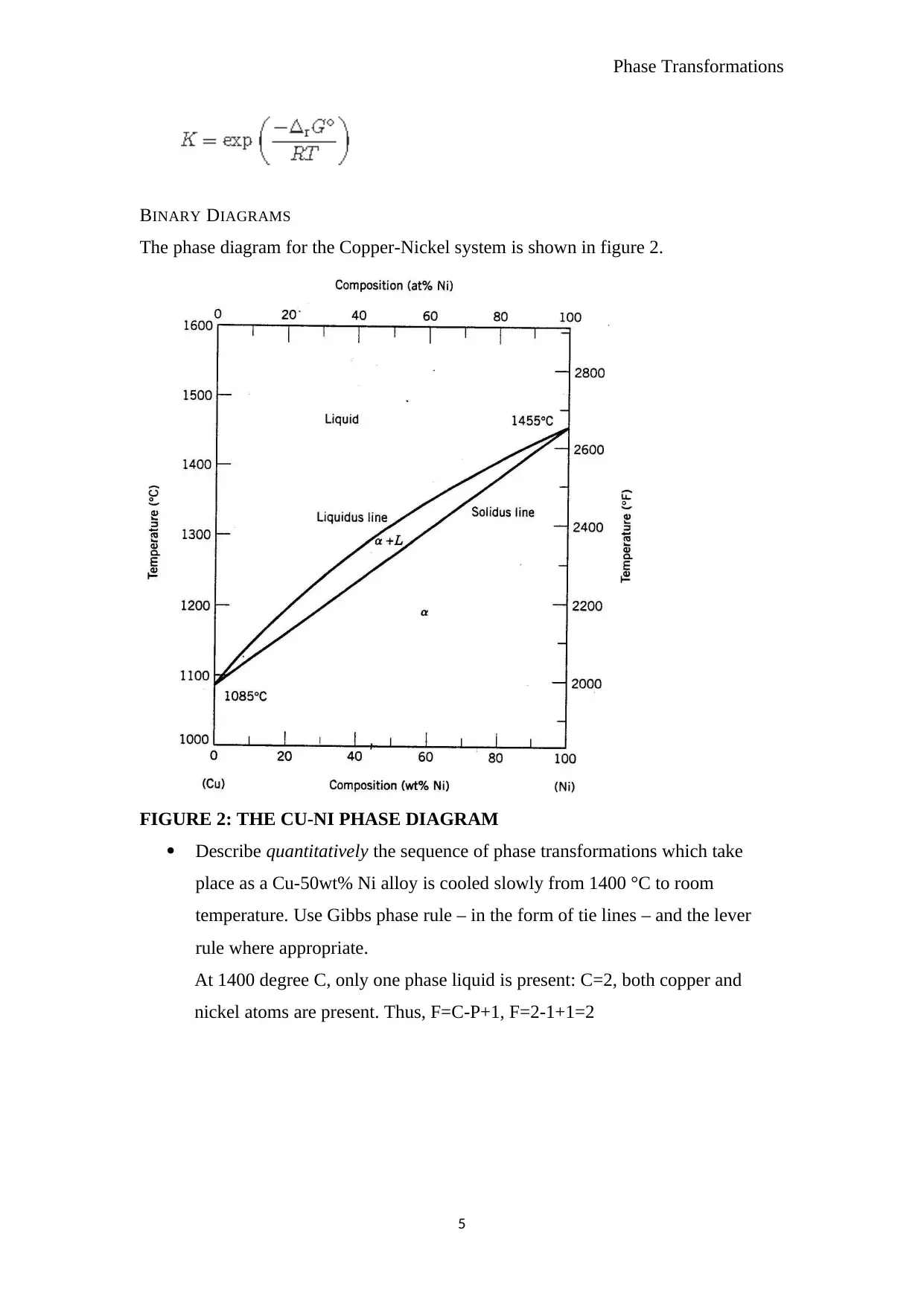
Phase Transformations
BINARY DIAGRAMS
The phase diagram for the Copper-Nickel system is shown in figure 2.
FIGURE 2: THE CU-NI PHASE DIAGRAM
Describe quantitatively the sequence of phase transformations which take
place as a Cu-50wt% Ni alloy is cooled slowly from 1400 °C to room
temperature. Use Gibbs phase rule – in the form of tie lines – and the lever
rule where appropriate.
At 1400 degree C, only one phase liquid is present: C=2, both copper and
nickel atoms are present. Thus, F=C-P+1, F=2-1+1=2
5
BINARY DIAGRAMS
The phase diagram for the Copper-Nickel system is shown in figure 2.
FIGURE 2: THE CU-NI PHASE DIAGRAM
Describe quantitatively the sequence of phase transformations which take
place as a Cu-50wt% Ni alloy is cooled slowly from 1400 °C to room
temperature. Use Gibbs phase rule – in the form of tie lines – and the lever
rule where appropriate.
At 1400 degree C, only one phase liquid is present: C=2, both copper and
nickel atoms are present. Thus, F=C-P+1, F=2-1+1=2
5
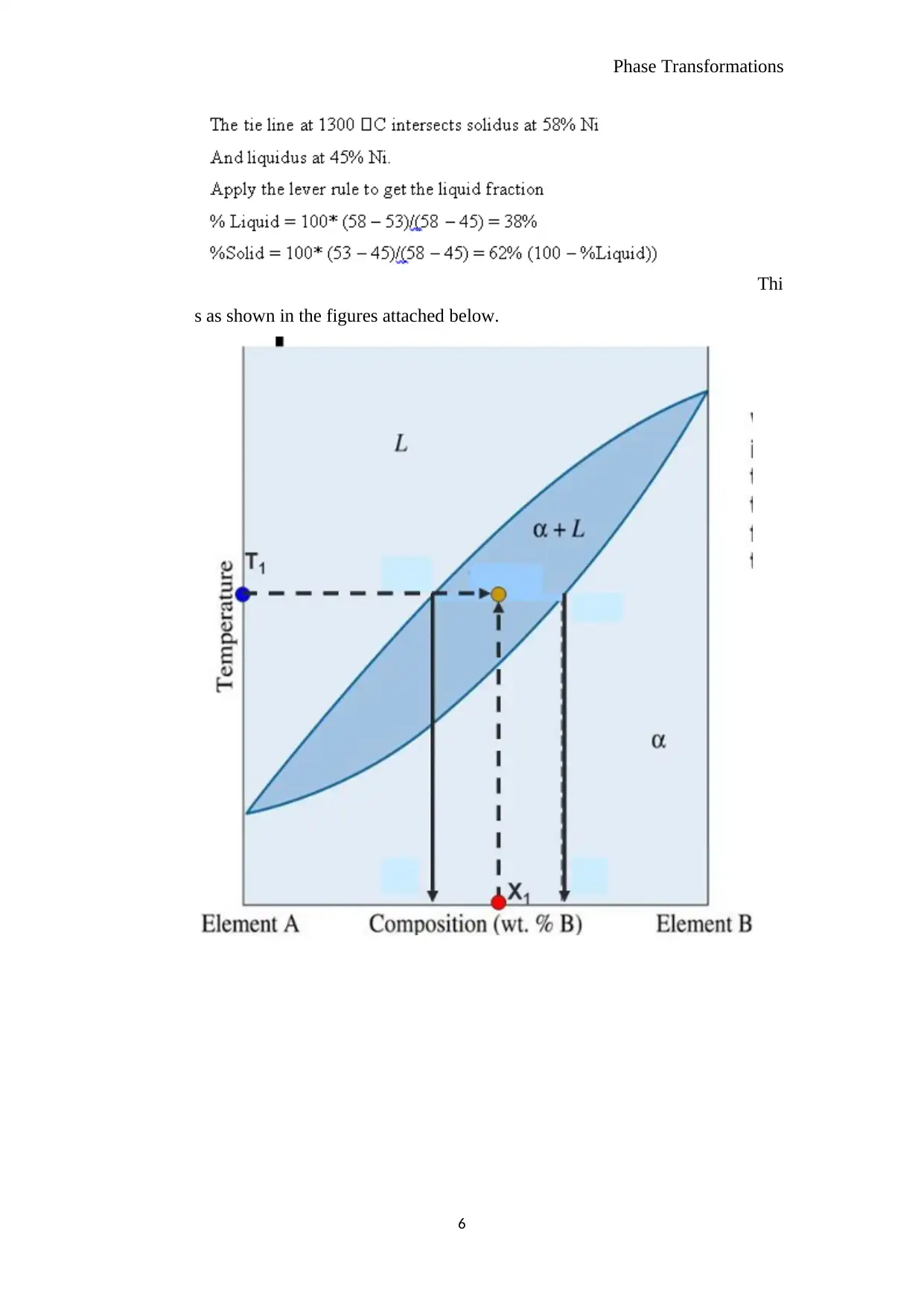
Phase Transformations
Thi
s as shown in the figures attached below.
6
Thi
s as shown in the figures attached below.
6
⊘ This is a preview!⊘
Do you want full access?
Subscribe today to unlock all pages.

Trusted by 1+ million students worldwide
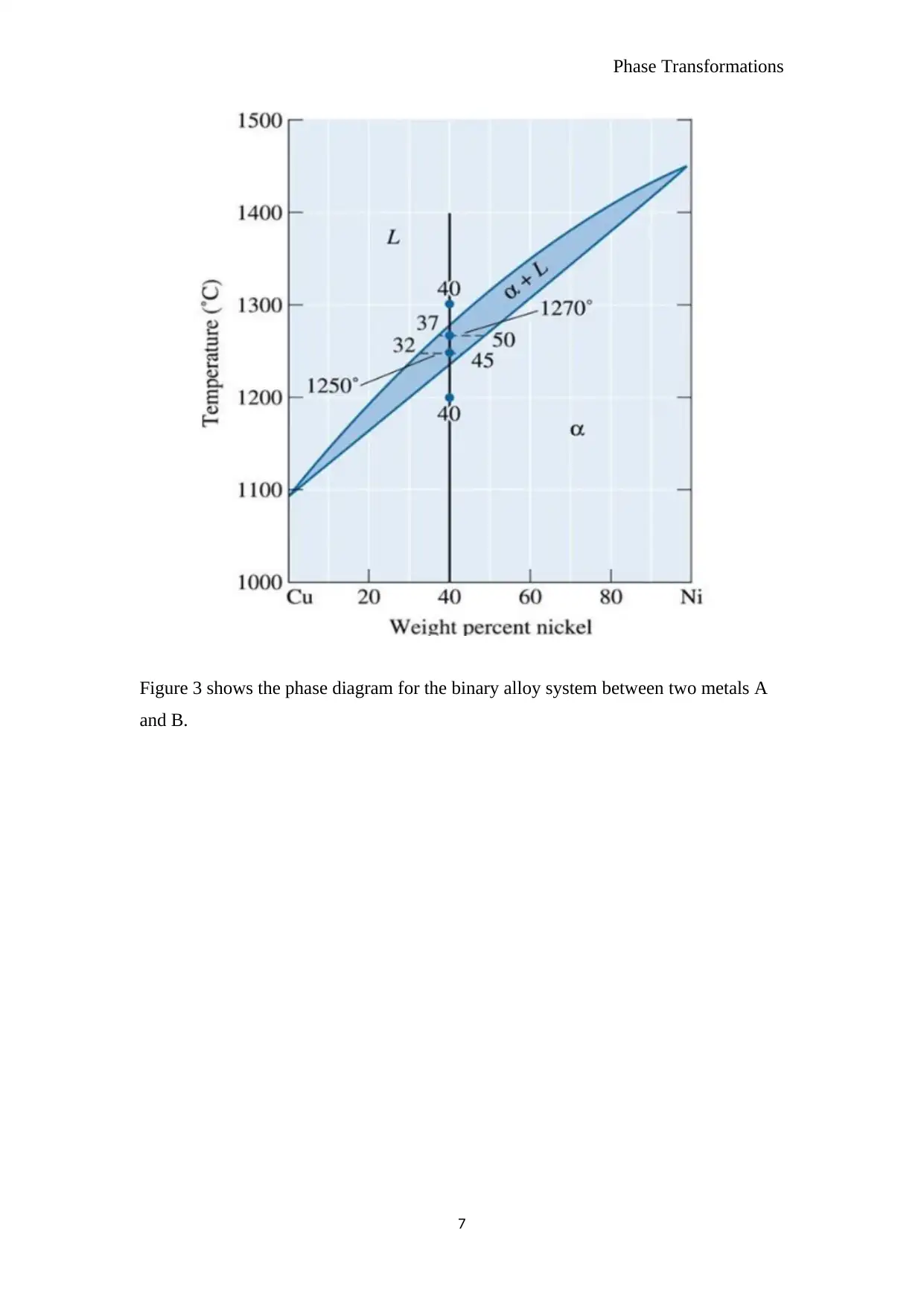
Phase Transformations
Figure 3 shows the phase diagram for the binary alloy system between two metals A
and B.
7
Figure 3 shows the phase diagram for the binary alloy system between two metals A
and B.
7
Paraphrase This Document
Need a fresh take? Get an instant paraphrase of this document with our AI Paraphraser
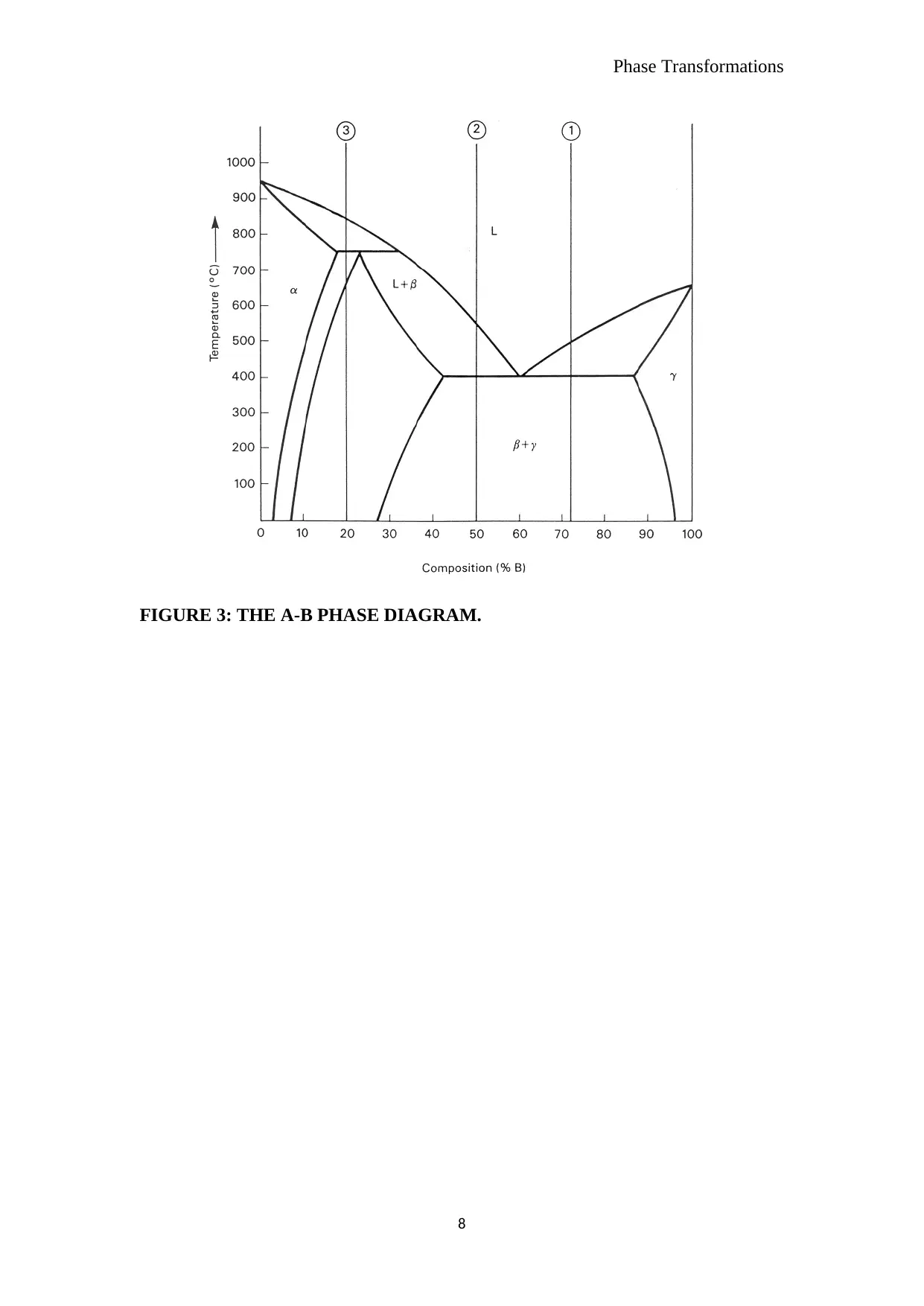
Phase Transformations
FIGURE 3: THE A-B PHASE DIAGRAM.
8
FIGURE 3: THE A-B PHASE DIAGRAM.
8
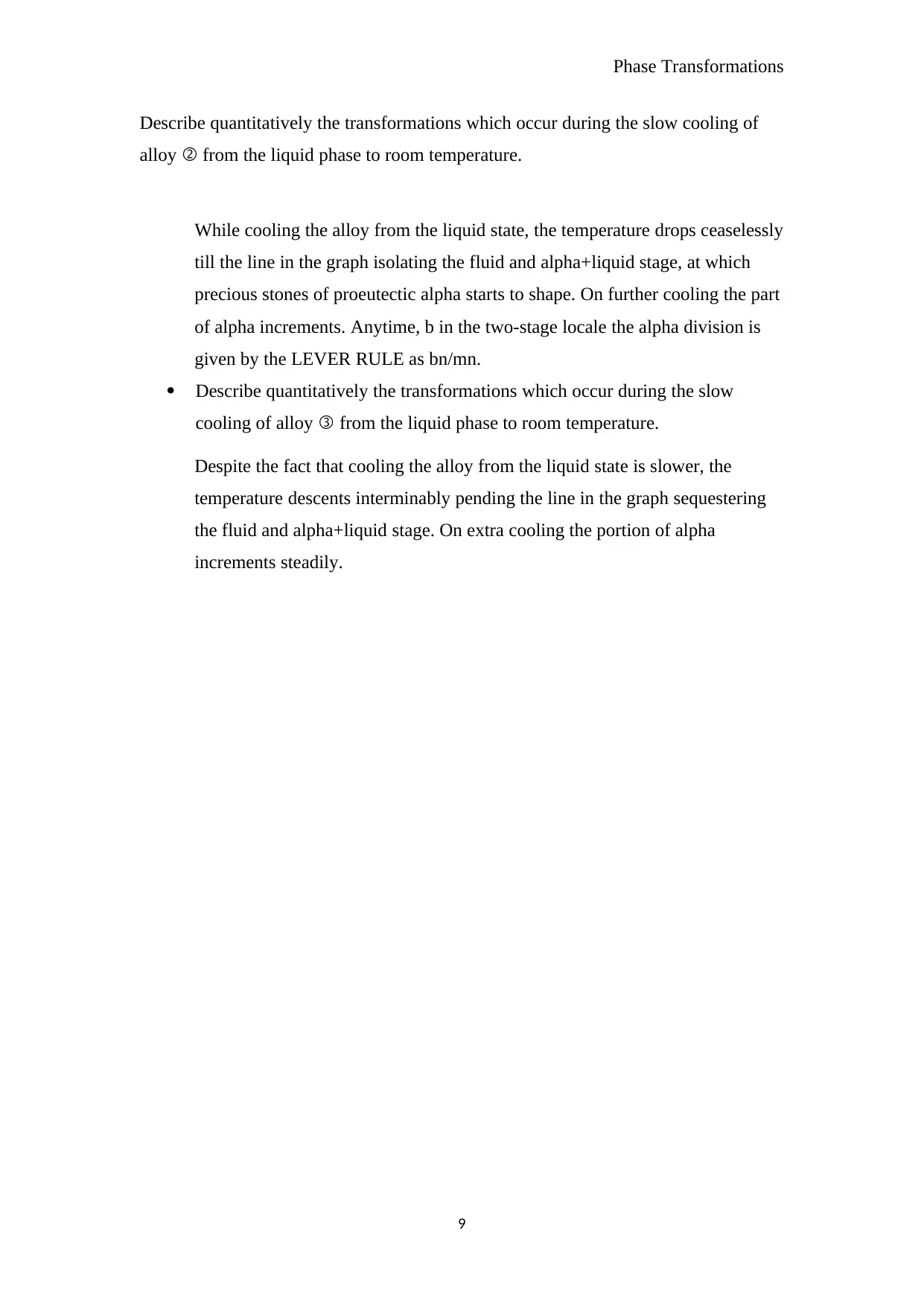
Phase Transformations
Describe quantitatively the transformations which occur during the slow cooling of
alloy from the liquid phase to room temperature.
While cooling the alloy from the liquid state, the temperature drops ceaselessly
till the line in the graph isolating the fluid and alpha+liquid stage, at which
precious stones of proeutectic alpha starts to shape. On further cooling the part
of alpha increments. Anytime, b in the two-stage locale the alpha division is
given by the LEVER RULE as bn/mn.
Describe quantitatively the transformations which occur during the slow
cooling of alloy from the liquid phase to room temperature.
Despite the fact that cooling the alloy from the liquid state is slower, the
temperature descents interminably pending the line in the graph sequestering
the fluid and alpha+liquid stage. On extra cooling the portion of alpha
increments steadily.
9
Describe quantitatively the transformations which occur during the slow cooling of
alloy from the liquid phase to room temperature.
While cooling the alloy from the liquid state, the temperature drops ceaselessly
till the line in the graph isolating the fluid and alpha+liquid stage, at which
precious stones of proeutectic alpha starts to shape. On further cooling the part
of alpha increments. Anytime, b in the two-stage locale the alpha division is
given by the LEVER RULE as bn/mn.
Describe quantitatively the transformations which occur during the slow
cooling of alloy from the liquid phase to room temperature.
Despite the fact that cooling the alloy from the liquid state is slower, the
temperature descents interminably pending the line in the graph sequestering
the fluid and alpha+liquid stage. On extra cooling the portion of alpha
increments steadily.
9
⊘ This is a preview!⊘
Do you want full access?
Subscribe today to unlock all pages.

Trusted by 1+ million students worldwide
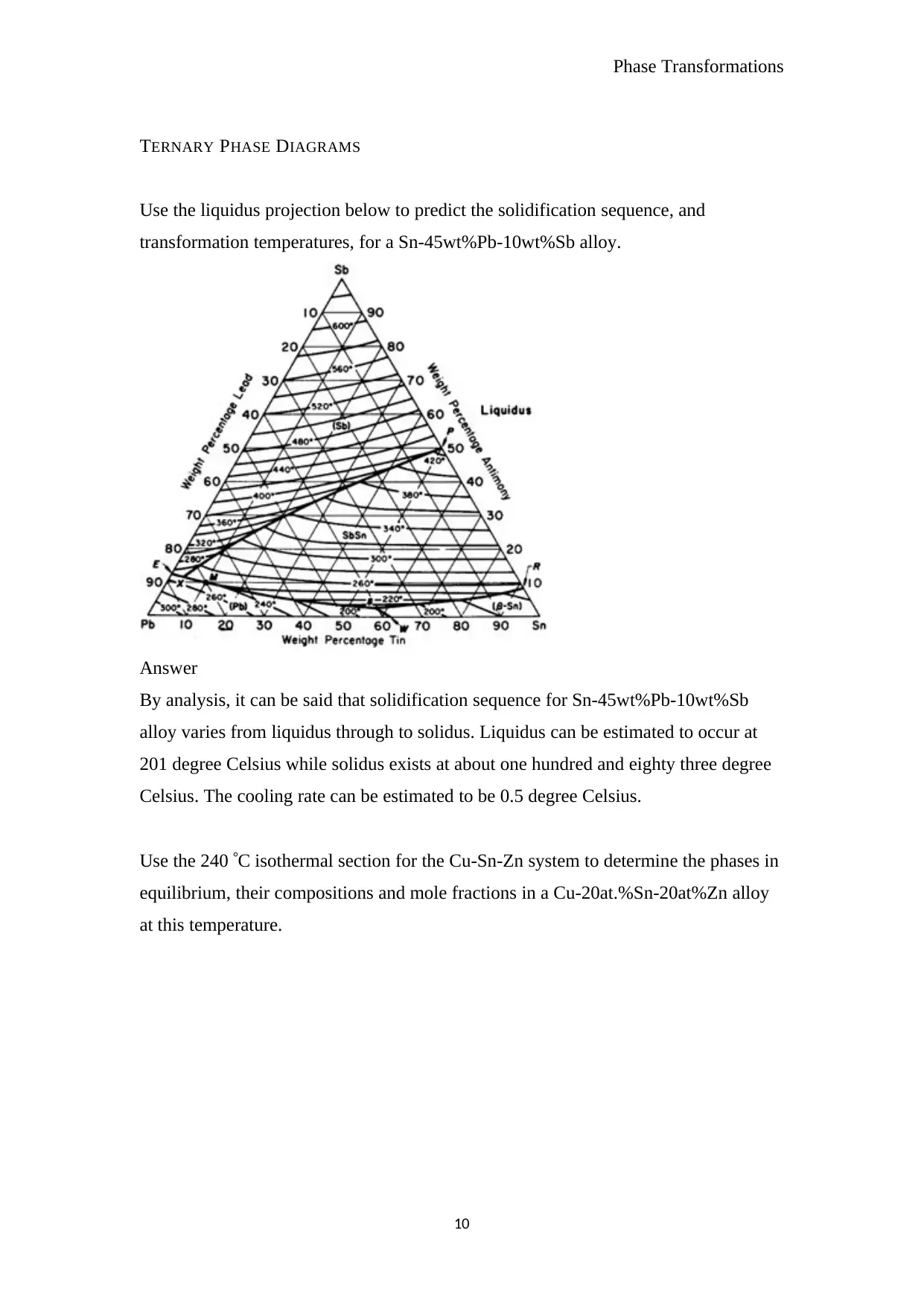
Phase Transformations
TERNARY PHASE DIAGRAMS
Use the liquidus projection below to predict the solidification sequence, and
transformation temperatures, for a Sn-45wt%Pb-10wt%Sb alloy.
Answer
By analysis, it can be said that solidification sequence for Sn-45wt%Pb-10wt%Sb
alloy varies from liquidus through to solidus. Liquidus can be estimated to occur at
201 degree Celsius while solidus exists at about one hundred and eighty three degree
Celsius. The cooling rate can be estimated to be 0.5 degree Celsius.
Use the 240 C isothermal section for the Cu-Sn-Zn system to determine the phases in
equilibrium, their compositions and mole fractions in a Cu-20at.%Sn-20at%Zn alloy
at this temperature.
10
TERNARY PHASE DIAGRAMS
Use the liquidus projection below to predict the solidification sequence, and
transformation temperatures, for a Sn-45wt%Pb-10wt%Sb alloy.
Answer
By analysis, it can be said that solidification sequence for Sn-45wt%Pb-10wt%Sb
alloy varies from liquidus through to solidus. Liquidus can be estimated to occur at
201 degree Celsius while solidus exists at about one hundred and eighty three degree
Celsius. The cooling rate can be estimated to be 0.5 degree Celsius.
Use the 240 C isothermal section for the Cu-Sn-Zn system to determine the phases in
equilibrium, their compositions and mole fractions in a Cu-20at.%Sn-20at%Zn alloy
at this temperature.
10
Paraphrase This Document
Need a fresh take? Get an instant paraphrase of this document with our AI Paraphraser
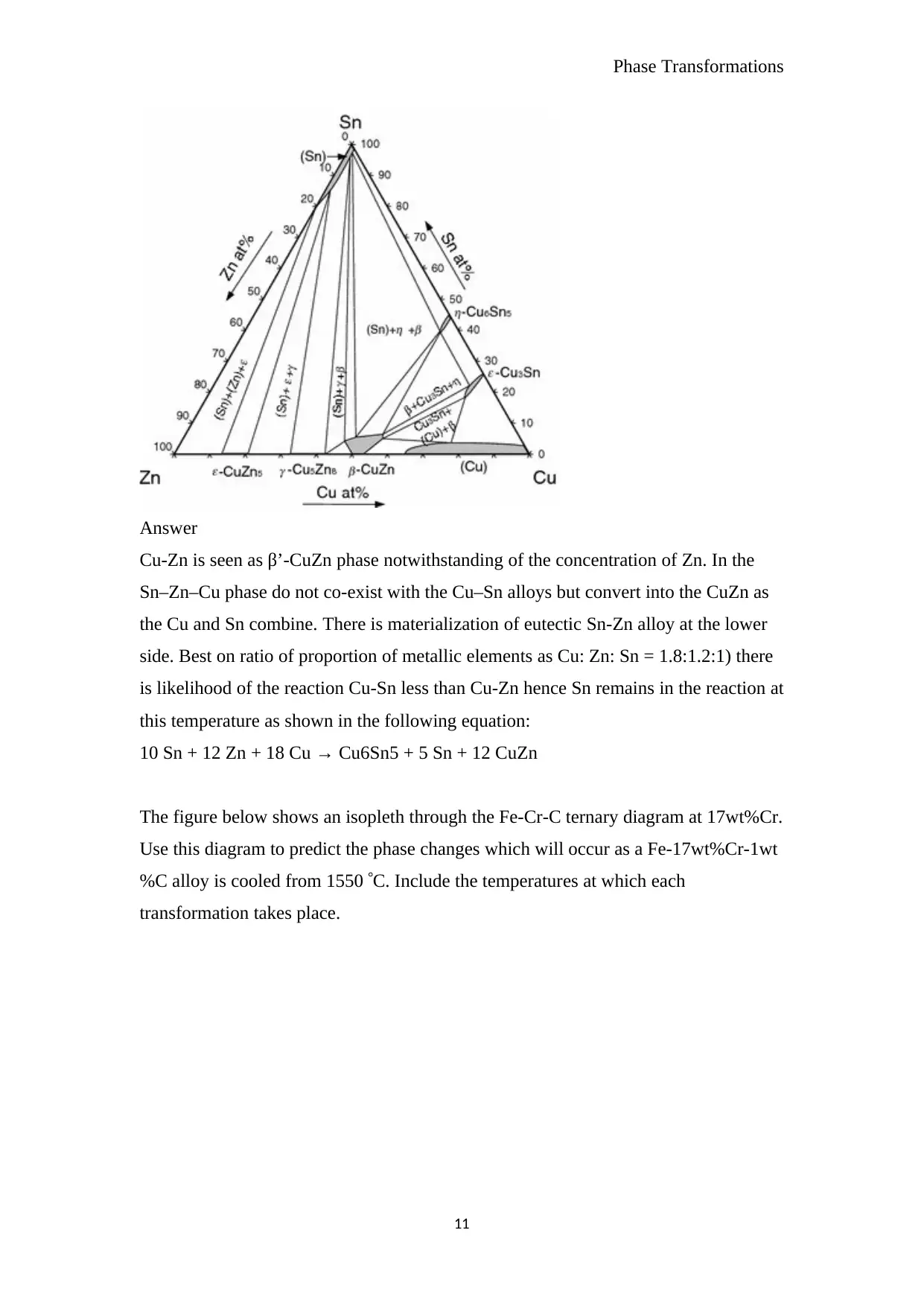
Phase Transformations
Answer
Cu-Zn is seen as β’-CuZn phase notwithstanding of the concentration of Zn. In the
Sn–Zn–Cu phase do not co-exist with the Cu–Sn alloys but convert into the CuZn as
the Cu and Sn combine. There is materialization of eutectic Sn-Zn alloy at the lower
side. Best on ratio of proportion of metallic elements as Cu: Zn: Sn = 1.8:1.2:1) there
is likelihood of the reaction Cu-Sn less than Cu-Zn hence Sn remains in the reaction at
this temperature as shown in the following equation:
10 Sn + 12 Zn + 18 Cu → Cu6Sn5 + 5 Sn + 12 CuZn
The figure below shows an isopleth through the Fe-Cr-C ternary diagram at 17wt%Cr.
Use this diagram to predict the phase changes which will occur as a Fe-17wt%Cr-1wt
%C alloy is cooled from 1550 C. Include the temperatures at which each
transformation takes place.
11
Answer
Cu-Zn is seen as β’-CuZn phase notwithstanding of the concentration of Zn. In the
Sn–Zn–Cu phase do not co-exist with the Cu–Sn alloys but convert into the CuZn as
the Cu and Sn combine. There is materialization of eutectic Sn-Zn alloy at the lower
side. Best on ratio of proportion of metallic elements as Cu: Zn: Sn = 1.8:1.2:1) there
is likelihood of the reaction Cu-Sn less than Cu-Zn hence Sn remains in the reaction at
this temperature as shown in the following equation:
10 Sn + 12 Zn + 18 Cu → Cu6Sn5 + 5 Sn + 12 CuZn
The figure below shows an isopleth through the Fe-Cr-C ternary diagram at 17wt%Cr.
Use this diagram to predict the phase changes which will occur as a Fe-17wt%Cr-1wt
%C alloy is cooled from 1550 C. Include the temperatures at which each
transformation takes place.
11
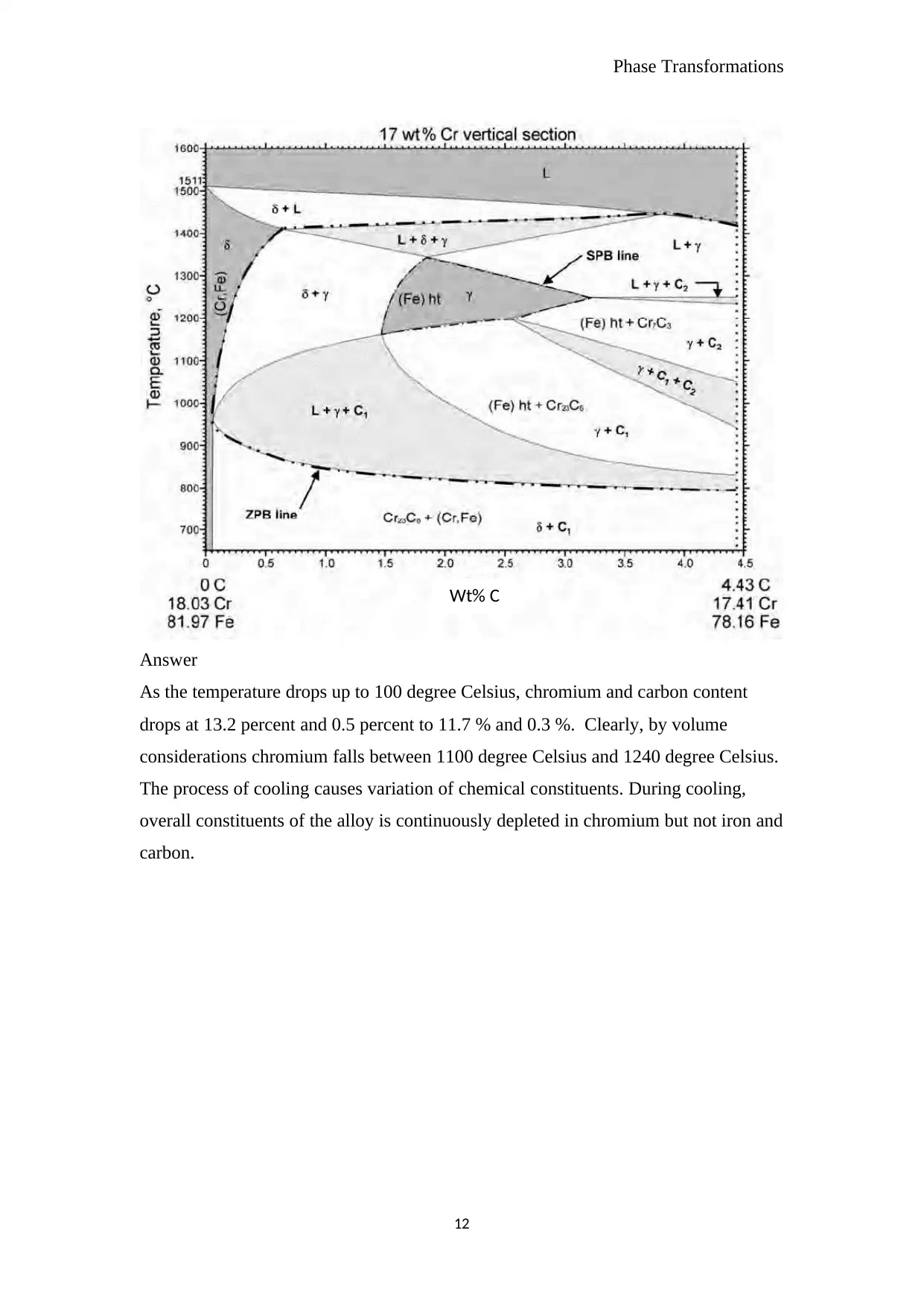
Phase Transformations
Answer
As the temperature drops up to 100 degree Celsius, chromium and carbon content
drops at 13.2 percent and 0.5 percent to 11.7 % and 0.3 %. Clearly, by volume
considerations chromium falls between 1100 degree Celsius and 1240 degree Celsius.
The process of cooling causes variation of chemical constituents. During cooling,
overall constituents of the alloy is continuously depleted in chromium but not iron and
carbon.
12
Wt% C
Answer
As the temperature drops up to 100 degree Celsius, chromium and carbon content
drops at 13.2 percent and 0.5 percent to 11.7 % and 0.3 %. Clearly, by volume
considerations chromium falls between 1100 degree Celsius and 1240 degree Celsius.
The process of cooling causes variation of chemical constituents. During cooling,
overall constituents of the alloy is continuously depleted in chromium but not iron and
carbon.
12
Wt% C
⊘ This is a preview!⊘
Do you want full access?
Subscribe today to unlock all pages.

Trusted by 1+ million students worldwide
1 out of 13
Your All-in-One AI-Powered Toolkit for Academic Success.
+13062052269
info@desklib.com
Available 24*7 on WhatsApp / Email
![[object Object]](/_next/static/media/star-bottom.7253800d.svg)
Unlock your academic potential
Copyright © 2020–2025 A2Z Services. All Rights Reserved. Developed and managed by ZUCOL.
